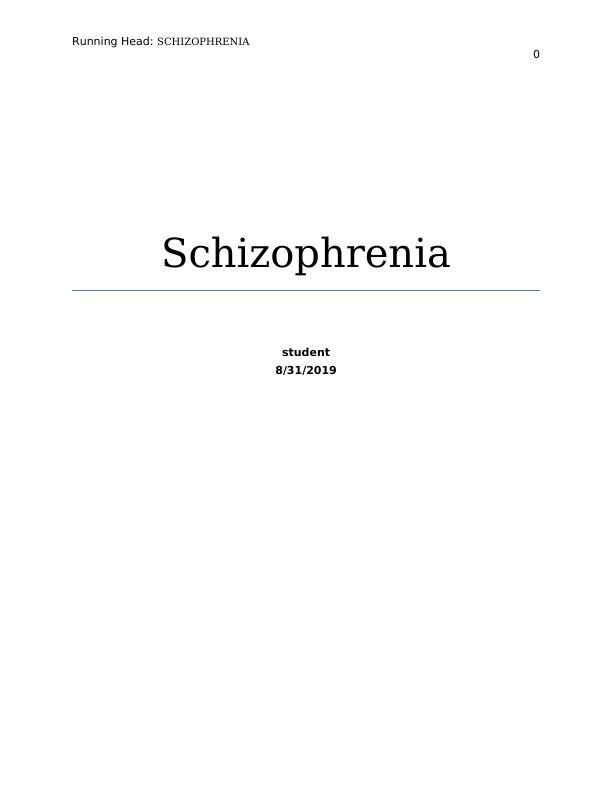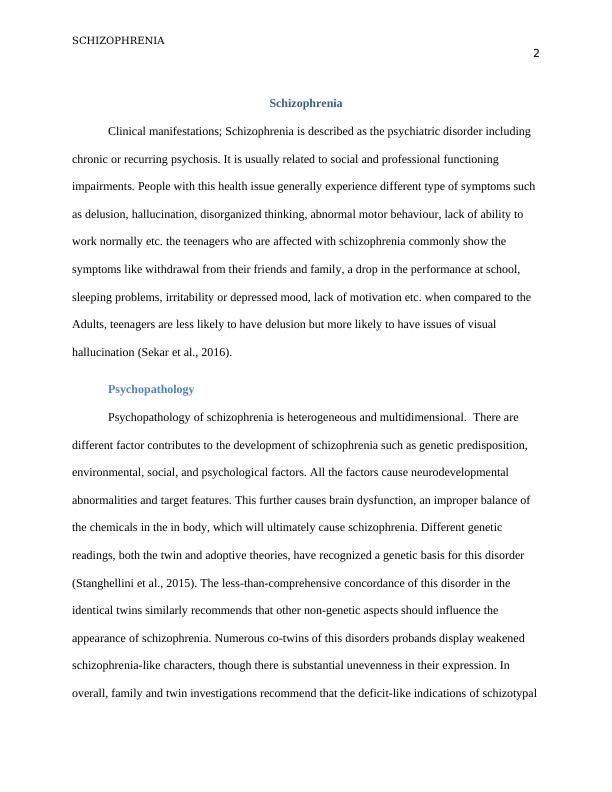The development of schizophrenia
Discuss the clinical manifestations and psychopathology of a major mental illness, along with the appropriate psychopharmacology and other treatment options.
12 Pages3077 Words10 Views
Added on 2022-09-14
The development of schizophrenia
Discuss the clinical manifestations and psychopathology of a major mental illness, along with the appropriate psychopharmacology and other treatment options.
Added on 2022-09-14
ShareRelated Documents
Running Head: SCHIZOPHRENIA
0
Schizophrenia
student
8/31/2019
0
Schizophrenia
student
8/31/2019

SCHIZOPHRENIA
1
Table of Contents
Schizophrenia................................................................................................................. 2
Psychopathology.......................................................................................................... 2
Psychopharmacology..................................................................................................... 3
Patient education.......................................................................................................... 5
Other treatment............................................................................................................ 6
Recovery planning........................................................................................................ 7
References..................................................................................................................... 9
1
Table of Contents
Schizophrenia................................................................................................................. 2
Psychopathology.......................................................................................................... 2
Psychopharmacology..................................................................................................... 3
Patient education.......................................................................................................... 5
Other treatment............................................................................................................ 6
Recovery planning........................................................................................................ 7
References..................................................................................................................... 9

SCHIZOPHRENIA
2
Schizophrenia
Clinical manifestations; Schizophrenia is described as the psychiatric disorder including
chronic or recurring psychosis. It is usually related to social and professional functioning
impairments. People with this health issue generally experience different type of symptoms such
as delusion, hallucination, disorganized thinking, abnormal motor behaviour, lack of ability to
work normally etc. the teenagers who are affected with schizophrenia commonly show the
symptoms like withdrawal from their friends and family, a drop in the performance at school,
sleeping problems, irritability or depressed mood, lack of motivation etc. when compared to the
Adults, teenagers are less likely to have delusion but more likely to have issues of visual
hallucination (Sekar et al., 2016).
Psychopathology
Psychopathology of schizophrenia is heterogeneous and multidimensional. There are
different factor contributes to the development of schizophrenia such as genetic predisposition,
environmental, social, and psychological factors. All the factors cause neurodevelopmental
abnormalities and target features. This further causes brain dysfunction, an improper balance of
the chemicals in the in body, which will ultimately cause schizophrenia. Different genetic
readings, both the twin and adoptive theories, have recognized a genetic basis for this disorder
(Stanghellini et al., 2015). The less-than-comprehensive concordance of this disorder in the
identical twins similarly recommends that other non-genetic aspects should influence the
appearance of schizophrenia. Numerous co-twins of this disorders probands display weakened
schizophrenia-like characters, though there is substantial unevenness in their expression. In
overall, family and twin investigations recommend that the deficit-like indications of schizotypal
2
Schizophrenia
Clinical manifestations; Schizophrenia is described as the psychiatric disorder including
chronic or recurring psychosis. It is usually related to social and professional functioning
impairments. People with this health issue generally experience different type of symptoms such
as delusion, hallucination, disorganized thinking, abnormal motor behaviour, lack of ability to
work normally etc. the teenagers who are affected with schizophrenia commonly show the
symptoms like withdrawal from their friends and family, a drop in the performance at school,
sleeping problems, irritability or depressed mood, lack of motivation etc. when compared to the
Adults, teenagers are less likely to have delusion but more likely to have issues of visual
hallucination (Sekar et al., 2016).
Psychopathology
Psychopathology of schizophrenia is heterogeneous and multidimensional. There are
different factor contributes to the development of schizophrenia such as genetic predisposition,
environmental, social, and psychological factors. All the factors cause neurodevelopmental
abnormalities and target features. This further causes brain dysfunction, an improper balance of
the chemicals in the in body, which will ultimately cause schizophrenia. Different genetic
readings, both the twin and adoptive theories, have recognized a genetic basis for this disorder
(Stanghellini et al., 2015). The less-than-comprehensive concordance of this disorder in the
identical twins similarly recommends that other non-genetic aspects should influence the
appearance of schizophrenia. Numerous co-twins of this disorders probands display weakened
schizophrenia-like characters, though there is substantial unevenness in their expression. In
overall, family and twin investigations recommend that the deficit-like indications of schizotypal

SCHIZOPHRENIA
3
personality illnesses or other schizophrenia-associated disorders might be most characteristic of
the schizotypal persons with a hereditary association to someone with schizophrenia. Patients
with schizophrenia share different psychophysiological deformities found in the chronic
schizophrenia delivers psychopathological relates or intermediate the phenotypes for this health
issue for example: A P50 suppression failure or the ability to “gate” or suitably moderate or
inhibit the sensory input that might leads to sensory burden and cognitive disorganization,
Insufficiencies in prepulse reticence, the capacity to constrain the startle reaction with a feeble
prestimulus, which might damage suitable modulation of environmental responsiveness
(Northoff & Duncan, 2016). Damage of smooth-pursuit eye activities, which permit the fovea to
uphold its emphasis on an easy moving target, replicating instinctive attention, Errors in the
antisaccade activities, which examine saccadic reticence, deprived performance on the backward
masking activity that measures early pictorial processing. Other factor includes deprived P300-
evoked capacities, which examines auditory attention, performance on the Unceasing
Performance Examination, and a continued attention task. Individuals with schizophrenia not
only show qualitative and quantitative damage in smooth-pursuit tracking but also perform less
precisely in antisaccade and emotion recognition tasks (Margariti et al., 2015).
Psychopharmacology
It is the scientific study of the impacts medicine have on the mood, sensation, thinking
and habits. It is different from the neuro-psychopharmacology, which focuses on the relation
between drug-induced alteration in the cell functioning. Antipsychotic drugs are the widespread
method of treating psychological diseases like schizophrenia. These drugs ease symptoms like
delusion and hallucinations. They work in the chemicals in the patient's brain like dopamine and
serotonin. The patients will more likely to take these drugs for their entire life, even if the
3
personality illnesses or other schizophrenia-associated disorders might be most characteristic of
the schizotypal persons with a hereditary association to someone with schizophrenia. Patients
with schizophrenia share different psychophysiological deformities found in the chronic
schizophrenia delivers psychopathological relates or intermediate the phenotypes for this health
issue for example: A P50 suppression failure or the ability to “gate” or suitably moderate or
inhibit the sensory input that might leads to sensory burden and cognitive disorganization,
Insufficiencies in prepulse reticence, the capacity to constrain the startle reaction with a feeble
prestimulus, which might damage suitable modulation of environmental responsiveness
(Northoff & Duncan, 2016). Damage of smooth-pursuit eye activities, which permit the fovea to
uphold its emphasis on an easy moving target, replicating instinctive attention, Errors in the
antisaccade activities, which examine saccadic reticence, deprived performance on the backward
masking activity that measures early pictorial processing. Other factor includes deprived P300-
evoked capacities, which examines auditory attention, performance on the Unceasing
Performance Examination, and a continued attention task. Individuals with schizophrenia not
only show qualitative and quantitative damage in smooth-pursuit tracking but also perform less
precisely in antisaccade and emotion recognition tasks (Margariti et al., 2015).
Psychopharmacology
It is the scientific study of the impacts medicine have on the mood, sensation, thinking
and habits. It is different from the neuro-psychopharmacology, which focuses on the relation
between drug-induced alteration in the cell functioning. Antipsychotic drugs are the widespread
method of treating psychological diseases like schizophrenia. These drugs ease symptoms like
delusion and hallucinations. They work in the chemicals in the patient's brain like dopamine and
serotonin. The patients will more likely to take these drugs for their entire life, even if the

End of preview
Want to access all the pages? Upload your documents or become a member.
